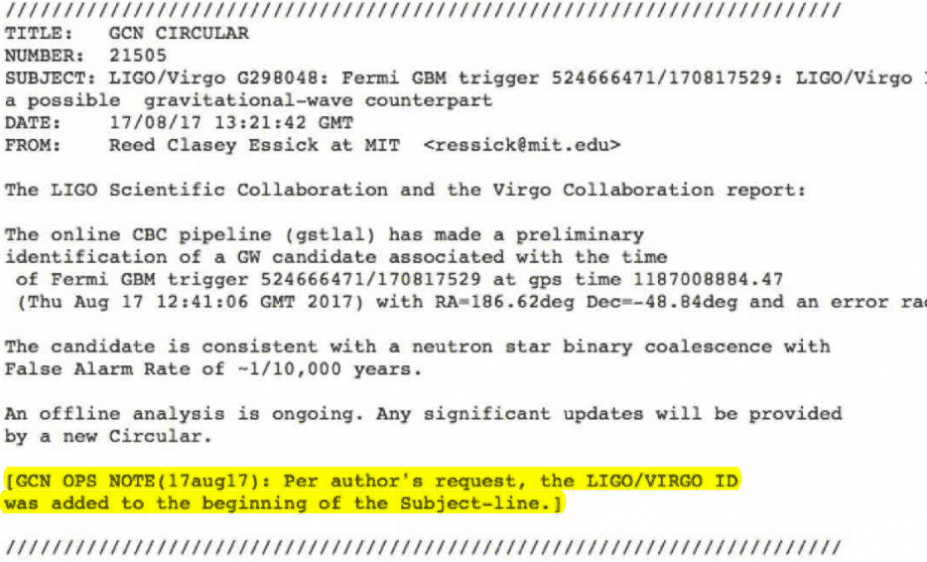Sabine Hossenfelder: Backreaction: What’s up with LIGO?
Fake News from the Universe?

The article continues:
It's quite interesting that even with the improved sensitivity, and better triangulation capacity with Virgo, the 03 LIGO run has still been unable to duplicate a single new example of "multimessenger astronomy". LIGO has been unable to verify their gravitational wave claims based on EM measurements or neutrino measurements since 2017. There have been over 40 new GW wave notifications in 2019, and yet not a single one of them has been verified by any external telescope or neutrino detector. The lack of any example of multimessenger confirmation in the O3 LIGO/Virgo run seems pretty suspicious considering all the problems with the original LIGO paper.
Evidence of gravitational waves, or evidence of confirmation bias?
Here's the event link to LIGO:
GraceDB | Latest
The 03 data set from 2019 can be summed up by the following entry in each of the events listed:
For most physicists, the 170817 neutron-star merger – the strongest signal LIGO has seen so-far – erased any worries raised by the Danish group’s claims. That’s because this event came with an electromagnetic counterpart that was seen by multiple telescopes, which can demonstrate that LIGO indeed sees something of astrophysical origin and not terrestrial noise. But, as critics have pointed out correctly, the LIGO alert for this event came 40 minutes after NASA’s gamma-ray alert. For this reason, the event cannot be used as an independent confirmation of LIGO’s detection capacity. Furthermore, the interpretation of this signal as a neutron-star merger has also been criticized. And this criticism has been criticized for yet other reasons.
Fake News from the Universe?
Postdiction instead of prediction
Therefore, for many who follow the latest developments in science, the strongest evidence for the observation of gravitational waves is the GW170817 signal discovered in August 2017 by LIGO and then confirmed by the Fermi (NASA) and Integral (ESA, though with very weak signal) gamma-ray telescopes. At any rate, this is how it was presented at the press conference.
To be a little bit more precise, however, Fermi had sent the notification email first, and LIGO needed four hours to "predict" the sky position--which matched the coordinates already known. The misleading impression that LIGO was the first one had a simple origin: they explicitly requested a modification to the subject line of the alert mail (see picture).

Note the subsequent change of the subject line by LIGO/Virgo.
The article continues:
However, since the beginning of the measurements at the beginning of April, there has not been any event worthy of attention. Instead, there have been many false alarms, surprising to the point of incomprehensibility. Why are there so many simultaneous "glitches" in three laboratories?
Particularly embarrassing was the one of May 10, 2019, in which the confidence level of the identification dropped from 98 percent to 85 percent and, finally, to 42 percent, after the alerted telescopes saw nothing. More mispredictions can be found here and here.
It's quite interesting that even with the improved sensitivity, and better triangulation capacity with Virgo, the 03 LIGO run has still been unable to duplicate a single new example of "multimessenger astronomy". LIGO has been unable to verify their gravitational wave claims based on EM measurements or neutrino measurements since 2017. There have been over 40 new GW wave notifications in 2019, and yet not a single one of them has been verified by any external telescope or neutrino detector. The lack of any example of multimessenger confirmation in the O3 LIGO/Virgo run seems pretty suspicious considering all the problems with the original LIGO paper.
Evidence of gravitational waves, or evidence of confirmation bias?
Here's the event link to LIGO:
GraceDB | Latest
The 03 data set from 2019 can be summed up by the following entry in each of the events listed:
No EM observation entries so far.
Last edited:
